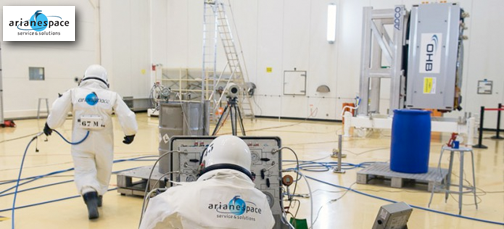
The fueling of Europe’s four Galileo satellites to be orbited on Arianespace Flight VA233 is being performed in the Spaceport’s S3B payload preparation facility.
Photo is courtesy of Arianespace.
Fueling operations have been initiated for the four Galileo spacecraft that will be orbited next month from French Guiana on Arianespace's first launch that uses their Ariane 5 to deploy Europe's constellation of navigation satellites.
The fueling activity is now underway in the Spaceport's S3B payload preparation facility. One of the first to be processed is named "Antonianna," named after an Italian child who won a European Commission Galileo drawing competition—with one winner selected from each member state of the European Union.
Weighing between 715 and 717 kg each, the quartet of Galileo satellites will have a combined liftoff mass of 2,865 kg and they will be deployed by Ariane 5 into a circular orbit during a mission lasting just under four hours.
The Ariane 5 launch, designated Flight VA233 in Arianespace's numbering system, is set for a morning departure from the Spaceport on November 17 at an exact liftoff time of 10:06:48 a.m. in French Guiana (13:06:48 p.m. Universal Time – UTC). Flight VA233 will mark Arianespace's first use of its heavy-lift Ariane 5 to loft Galileo satellites, following seven previous missions with the company's medium-lift Soyuz. The Soyuz vehicles carried a pair of Galileo spacecraft on each flight, delivering a total of 14 navigation satellites into orbit since 2011.
Galileo is an important infrastructure program for Europe, creating a civil global satellite navigation system that provides highly accurate positioning with great precision and reliability. This program is funded and owned by the European Union, with overall responsibility for management and implementation held by the European Commission. The European Space Agency has been assigned design and development of the new generation of systems and infrastructure for Galileo.
OHB System in Bremen, Germany built the rectangular-shaped satellites, which are sized at 2.7 x 1.2 x 1.1 meters, with their navigation payloads provided by Surrey Satellite Technology in the United Kingdom.

